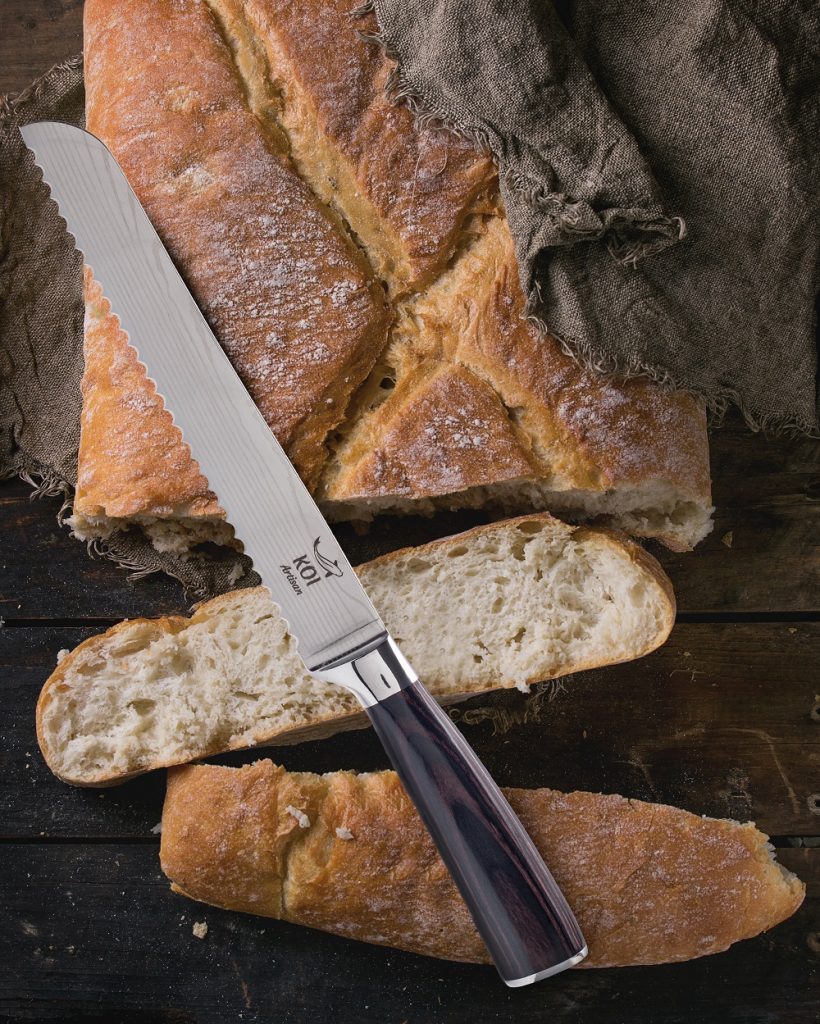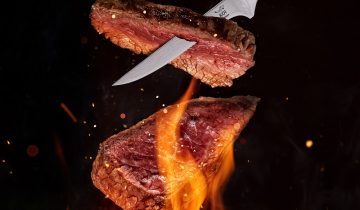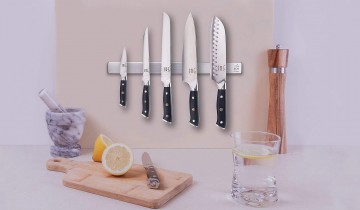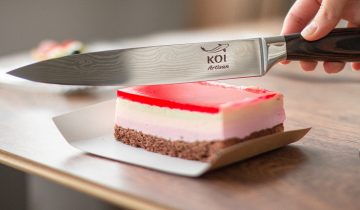Bread knives play a specific role in your kitchen blade collection. You won’t use a bread knife nearly as often as you would a chef’s knife, the actual workhorse of the kitchen, but they are important for a certain set of duties. What sets them apart is their serrated blade, which has a saw-toothed edge that can quickly cut through even the toughest and most delicate materials.
A bread knife’s main function is to slice bread. An excellent bread knife should be able to cut through a strong crust without crushing or mangling the sensitive crumb inside. Other knives are frequently unsuitable for this task, as extremely hard crusts can destroy finely sharpened blade edges, and any blade that isn’t sharp enough may require too much downward pressure, shattering the light bread. Bread knives can also be used for comparable purposes, such as levelling delicate and soft cake layers.
KOI Artisan bread knife is frequently your best choice for successfully slicing through a ripe tomato without damaging it, unless you keep your other blades exceedingly sharp. Bread knives cut directly through tomato skin with their teeth, so you don’t have to press down and risk crushing the delicate flesh underneath. Bread knives can also be used to cut thick-skinned melons and tough winter squash, since their teeth can glide through stiff, resistant peels when other blades get stuck and fail.

A straight-edged slicing knife is ideal for carving huge cuts of meat, such as prime rib or brisket, but most of us don’t chop enough large roasts at home to justify the extra storage space in our knife drawers. KOI Artisan bread knife works well as a substitute.
Types of Bread Knives
When picking a bread knife, there are a few design elements to keep in mind.
The first consideration is length. The blades I tested ranged in length from seven inches to slightly more than ten inches. Because some of the meals you’ll be cutting with a bread knife are fairly enormous, such as giant loaves of bread and watermelons, I recommend getting one that’s at least nine inches long.
The next consideration is shape: most bread knives are straight, with the handle aligned with the blade, while some are offset, with the blade lower than the handle. This is due to the thinness of most bread knife blades, which leaves little to no room for your fingers when the blade is close to the cutting board. When slicing through a loaf, this can cause your knuckles to grind on the board for the last few strokes. In my tests, however, the offset knives’ performance was not good enough to recommend them, despite the fact that I enjoy the design. (However, if you come across one you like, go for it.) The good news is that my two top picks were so successful that I never had to worry about my knuckles catching on the board. It helps that they both have lengthy blades, allowing you to take your hand off the board while the blade effortlessly cuts whatever you’re cutting.
The serrated edge’s form is the third factor to examine. The pointy-toothed edge was present on all of the knives I tested, but some people like the less frequent wavy-shaped design. I have a few wavy serrated knives at home, and they’ve always been fine, but not exceptional enough to persuade me that the design is intrinsically superior. Even between pointy-tipped serrated knives that appeared practically indistinguishable to my eye, I noticed a significant difference in performance. Two knives with nearly identical serrations could function dramatically differently, with one performing an outstanding job and the other doing a bad job.
In their studies, Cook’s Illustrated looked at the serration design and discovered that knives with more widely spread teeth performed better. That could be true, yet I held all of my knife blades side by side and couldn’t tell the difference in spacing in most cases.
Another crucial factor to consider, especially if you’re trying to save money, is maintenance: KOI Artisan bread knife’s serrated edge can be sharpened by passing each scallop up and down on a honing steel (a time-consuming task!), but it’s considerably more difficult to sharpen than other knives’ serrated edges. This is true for both a $200 knife and a $30 knife. You could mail it to be properly sharpened, or you could try to do it yourself, but I think it’ll be more hassle than it’s worth. Instead, my recommendation for most people is to simply replace their bread knife as the edge begins to wear out.

Testing and Results
For testing, slice a baguette into small rounds, sliced a huge, rustic loaf with a very firm crust, slice a tender and delicate loaf of white sandwich bread, slice ripe tomatoes as thinly as possible, and slice hard butternut squash (both cutting through the squash and using the knives to remove the peel).
While there were obvious differences in performance among the knives on each of these activities, the soft sandwich bread test was the one that most clearly highlighted the superiority of my top two blades. Except for those two, no knife could cut through the delicate loaf without mutilating it. The bread after one of my many futile attempts to slice it neatly is shown on the left; on the right, you can see how nicely the KOI Artisan blade cut through it.
Every other test followed the same pattern as the tender sandwich bread test, albeit to a lesser extent. My two top knives made the thinnest, cleanest slices while slicing tomatoes. Many of the other blades were also capable of slicing the tomato, although not as cleanly or easily.
My two top picks performed best while slicing squash, while the remaining knives coped but didn’t breeze through it. The Dexter-Russell shone out for cutting the squash in half, thanks to its strong, heavy-duty blade, while the KOI Artisan excelled at peeling the squash.
Serrations
Bread knives feature a serrated edge that looks like a saw, with sharp points and hollows called gullets in between. This jagged edge makes it easier to cut through products like bread that have a hard outside but a soft inner, or tomatoes that have a slippery exterior. The pointed teeth puncture the surface, while the gullets limit friction and avoid ripping between the knife and the meal.
You’ve undoubtedly gone off course when cutting different ingredients with separate blades unless you have a rock-steady hand. The serrated edge on a KOI Artisan bread knife reduces the danger of it going off.

Types of Serrated Edges
It’s likely that you’ve observed that not all bread knives are created equal. Some people have more incisors than others. Some have sharper teeth than others. Bread knives have several types of serrations depending on the brand. Some knives have sharp teeth with deep hollows between them, while others have rounder teeth and a gentler profile.
Cutting with sharp pointed serrations requires less pressure. They are better at cutting through hard surfaces, but they also produce more crumbs. Rounded teeth need greater force but generate fewer crumbs.
22.9cm KOI Artisan Classic Bread Knife
Number of teeth
When you cut bread, it might sometimes come out rough instead of smooth. The number of teeth on a KOI Artisan bread knife influences whether the cut will be harsh or smooth. The larger the gullet between the teeth is, the fewer there are. Remember that the gullet is what keeps the knife from rubbing against the meal. As a result, the larger the gullet, the less friction, and hence the smoother the cut.

The Shape of the Blade
Most bread knives are straight, with the handle aligned with the blade. The blade on some, however, is significantly lower than the handle. This will keep your knuckles from rapping against the cutting board as you approach closer to the bottom of the thing you’re cutting. You can also regulate what you’re doing using an offset blade. You get greater outcomes since you can see how you’re cutting.



 No products in the cart.
No products in the cart.